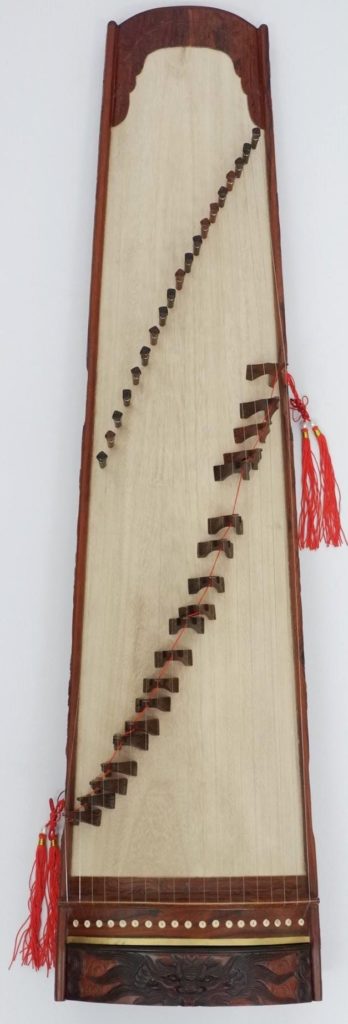A Popular Vietnamese Traditional Musical Instrument: Đàn Tranh Posted by Kandle Dart on Mar 24, 2022 in Art, Culture, Vocabulary
One of the most popular Vietnamese traditional musical instruments is the đàn tranh, also known as đàn thập lục (16-string instrument). Đàn tranh is a Vietnamese zither, similar to the Chinese guzheng, Japanese koto, Korean gayageum, or Mongolian yatga.
It is believed that the Đàn tranh was in use in Vietnam at least since the 12th century during the Trần dynasty. By the 19th century, during the Nguyễn dynasty, đàn tranh officially was part of the royal concert orchestra. The reason it was also called đàn thập lục is because many years ago it had sixteen strings. The modern đàn tranh has seventeen strings. In the past few decades, it has increased in size as well as the number of steel strings from seventeen to nineteen, twenty-two, twenty-five, and even twenty-nine. However, the standard string count is still seventeen.
The standard seventeen string Đàn tranh has three cung (octaves). Each cung has five notes. The music generally is based on the thang ngũ cung (pentatonic scale). The strings are tuned in this order, usually starting with Sol (G), though not always:
| Hò | Xự | Xang | Xê | Cống |
| Sol | La | Do | Re | Mi |
| G | A | C | D | E |
Below is a sample of traditional Huế Royal Court music.
To create the Fa (F) note, press the E string down. For the Si (B) notes, press the La (A) string down. It takes some practice to get the right F and B pitch. Đàn tranh is not limited to playing just Vietnamese traditional and folk music. It can produce western classical, contemporary music, or join in concert with other western instruments. Let’s listen to Serenade by Schubert, arranged and played for the đàn tranh by Hồ Thụy Trang as an example.
Is it easy to learn đàn tranh?
Yes, you can learn it quickly. It’s easy to play the basics. However, it’s hard to get to its “soul”. Đàn tranh’s music is based on melodies. Like singing, the artist has to know and “feel” each note on both hands. While the right-hand is used to pluck the strings to give sounds for the melody, it’s the left-hand that gives the tone, pitch, and ornamentation of the music piece. This is why I love to play đàn tranh. Its flexible strings allow me to tell my own unique story and moods.
In the past, the musician plucked the strings with the thumb and index finger on the right hand. Nowadays, playing with three fingers has become more standard. In some music pieces, the artist may use four to five fingers. You do need to wear finger picks to pluck the strings. The picks are usually made of tortoise shell or metal like brass or inox.
Some Basic Techniques for the Left Hand
- Rung (Vibrato)
- Vỗ (Tap)
- Nhấn (Press)
- Vuốt (Slide)
I would say, among all the Vietnamese traditional musical instruments, đàn tranh remains the most popular, widely known, and played by the Vietnamese. Below is a piece I found in which the artist applies many of techniques mentioned above.
How much does it cost to buy a standard đàn tranh?
Compared to the Chinese and Japanese zither models, the Vietnamese zither is much more affordable. The price ranges from $200 USD on the low end, and $500 USD for a mid-range model, and $1,000-$1,500 on the high end.
I found this video to be very informative about the introduction of đàn tranh.

Build vocabulary, practice pronunciation, and more with Transparent Language Online. Available anytime, anywhere, on any device.




